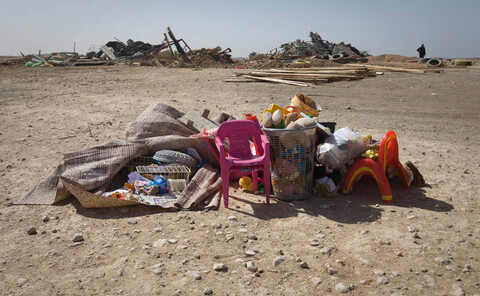The Electronic Intifada 5 July 2016

Ahlam Khalil stands in front of structure demolished by state authorities in the unrecognized Naqab village of Atir in 2014.
Ahlam Khalil, 19, rejects the future that the Israeli government has laid out for her.
“We want to stay. The government is trying to take from us all that we love. How do you think we will feel? It will be the hardest thing to face,” she says, sitting on her porch in the Bedouin village of Atir in the Naqab desert in the south of present-day Israel.
Following more than a decade of litigation, the Israeli high court ruled in May last year that the state is legally authorized to demolish Atir along with neighboring Umm al-Hiran.
Atir will become an extension of the planted forest of Yatir, while Umm al-Hiran will become the Jewish settlement of “Hiran.”
Unrecognized
The villages, their populations totaling approximately 1,000 inhabitants, are two of approximately 40 Palestinian Bedouin communities in the Naqab, which Israel calls the Negev, that are not recognized by the state and do not receive basic services such as water or electricity.
In many cases, these villages pre-date the State of Israel. In the case of Umm al-Hiran and Atir, its residents were forcibly transferred there in 1956 by military order from their original village of Khirbet Zubaleh, “which they had cultivated for centuries,” according to the rights group Adalah.
The government has been accelerating development in the Naqab. New roads, industrial zones, military bases and railway lines are being built to transform this once marginalized region into an “Israeli Silicon Valley.”
Forcible transfer
But these plans aren’t to the benefit of indigenous Bedouin communities. Adalah’s Suhad Bishara says that “most of [Israel’s] development plans are directed to bringing Jewish communities to the area, especially in the Naqab.”
Instead of providing them with badly needed services, in recent years the Israeli government has sought to forcibly transfer tens of thousands of Bedouins living in unrecognized communities in the Naqab — a scheme known as the Prawer Plan.
Mass protests scuppered this plan, but Adalah says that the high court ruling on Atir and Umm al-Hiran “gives the state broader legal scope for destroying these communities.”
And so residents like Ahlam Khalil insist on recognition — not demolition.
Silvia Boarini is a photojournalist based in Bir al-Saba and is currently working on a documentary about Naqab Bedouins.

The vast expanse of the Naqab desert. The Bedouin community, numbering approximately 230,000 people, represents 31 percent of the Naqab’s population. But only 18 out of the existing 133 developments in the area are designated for the Bedouin populations, according to Israeli government figures. There are some additional 40 villages not recognized by the state.

A home in Umm al-Hiran.

Clothes flutter in the wind outside Ahlam’s house in Atir.

Children play outside their home in Umm al-Hiran. The nearest school for the children in both villages is in the nearby recognized Bedouin township of Hura.

A view of Atir. In the background, the Jewish National Fund’s Yatir forest. An extension of the forest has been approved for planting on top of the lands of Atir.

A car decorated for a wedding outside a home in Umm al-Hiran. “People get married, they build houses, new families are formed. In the past two months, we had seven weddings. But the state is trying to displace us,” says Ahlam in Atir.

Muntaha Khalil, Ahlam’s sister, holds her baby Naima in Atir. “The state must recognize our village, we like living here, like this,” says Ahlam.

The mosque in Umm al-Hiran. “The is no justification, neither moral nor legal, for demolishing the villages,” says Suhad Bishara, an attorney with the rights group Adalah.

Earlier this year Umm al-Hiran hosted the annual Land Day march, which commemorates the deaths of six Palestinian citizens of Israel killed by police in March 1976 while protesting land expropriation. The sign reads: “Our future!!! Tantur…” The sign supporting Palestinian refugees’ right of return refers to a Palestinian village which was ethnically cleansed by Zionist militias in 1948.

A home in Umm al-Hiran, where despite the lack running water and electricity, residents have built a thriving community.

Ahlam Khalil films in Atir; her footage is collected by the Negev Coexistence Forum for Civil Equality, which uses it for advocacy purposes. “We are able to get pictures of demolitions and police brutality or police coming into village on a daily basis, and we use this material in reports and we deliver it to the media. It’s a powerful tool when it’s coming from the community itself,” Haia Noach, director of the group, said.

A view of Hura, where the Israeli government wants to forcibly transfer the residents of Atir and Umm al-Hiran. Hura is one of seven townships planned by the government to urbanize the agrarian Bedouin population since the 1960s. “The future of the Bedouins is in their villages. Israel should recognize them and the rights of the Bedouins as citizens,” said Kaed Abu al-Qian, the deputy mayor of Hura.





